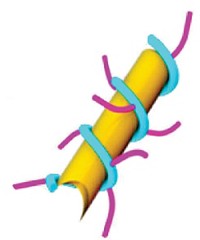Advertisement
Grab your lab coat. Let's get started
Welcome!
Welcome!
Create an account below to get 6 C&EN articles per month, receive newsletters and more - all free.
It seems this is your first time logging in online. Please enter the following information to continue.
As an ACS member you automatically get access to this site. All we need is few more details to create your reading experience.
Not you? Sign in with a different account.
Not you? Sign in with a different account.
ERROR 1
ERROR 1
ERROR 2
ERROR 2
ERROR 2
ERROR 2
ERROR 2
Password and Confirm password must match.
If you have an ACS member number, please enter it here so we can link this account to your membership. (optional)
ERROR 2
ACS values your privacy. By submitting your information, you are gaining access to C&EN and subscribing to our weekly newsletter. We use the information you provide to make your reading experience better, and we will never sell your data to third party members.
Biological Chemistry
Self-Assembling Nanoparticles Sneak Antisense RNA Into Cells
Nanomedicine: Nanoparticles with a polymer core and a nucleic acid shell regulate gene expression in human cells
by Laura Cassiday
May 22, 2014

Since the 1980s, researchers have pursued antisense nucleic acids as a way to reduce the expression of disease-causing genes. But delivering the sequences into a cell and protecting them from degradation have proved challenging. Using a new type of nanoparticle, a California team has successfully delivered antisense RNA into a cell and used it to shut down the expression of a cancer-related gene (J. Am. Chem. Soc. 2014, DOI: 10.1021/ja503598z).
To build antisense nucleic acid strands, researchers design a short stretch of DNA or RNA complementary to a messenger RNA target. Inside cells, the antisense sequence binds to the mRNA and dampens its expression, either by triggering its degradation by enzymes called nucleases, or by physically blocking the protein translation machinery.
To facilitate delivery and avoid degradation, researchers have looked to nanoparticles to help escort sequences inside cells. But synthesizing these modified nanoparticles can be complex, and some worry about their toxicity in living tissues. To help overcome these problems, researchers led by Nathan C. Gianneschi at the University of California, San Diego, designed a new type of nanoparticle that displays about 100 copies of an antisense RNA sequence on its surface.
The antisense sequence targets the mRNA of survivin, a protein implicated in several types of cancer. The sequence contains modified RNA bases known as locked nucleic acids (LNAs), which help the antisense sequence bind more tightly to its mRNA target and shield it from degradation by nucleases.
To make a self-assembling nanoparticle, the researchers attached the antisense LNA to a norbornyl polymer. Dispersed in water, this LNA–polymer conjugate spontaneously formed micelles, with a hydrophobic polymer core surrounded by a hydrophilic LNA shell.
Using LNA labeled with dye on the free end, Gianneschi and his colleagues showed that cultured human cells took in the LNA-polymer nanoparticles about 10 times more efficiently than the antisense LNA alone. The antisense LNA also appeared to trigger increased degradation of the mRNA by nucleases. The antisense nanoparticles reduced the survivin mRNA levels in treated human cancer cells by approximately 70% compared with experiments with nanoparticles that displayed a nonspecific LNA.
Chad A. Mirkin at Northwestern University calls Gianneschi’s work “spectacular.” Mirkin’s group developed similar structures, called spherical nucleic acids, with RNA or DNA strands attached to a gold nanoparticle core. The new LNA-polymer nanoparticles combine many of the advantages of conventional spherical nucleic acids with a less toxic hydrophobic polymer core, which may make them even more useful for biological applications, Mirkin says.
Gianneschi admits that the work has a long way to go before it could reach the clinic. They’ve demonstrated that the nanoparticles can get into cells and have an effect, he says, “but the number of challenges are massive when you go into actual live animals.” For now, Gianneschi is interested in using the LNA-polymer nanoparticles as a research tool to study cellular processes by blocking gene expression. In addition, he would like to use the technology to display RNA aptamers that target cellular proteins and modify their activity.



Join the conversation
Contact the reporter
Submit a Letter to the Editor for publication
Engage with us on Twitter